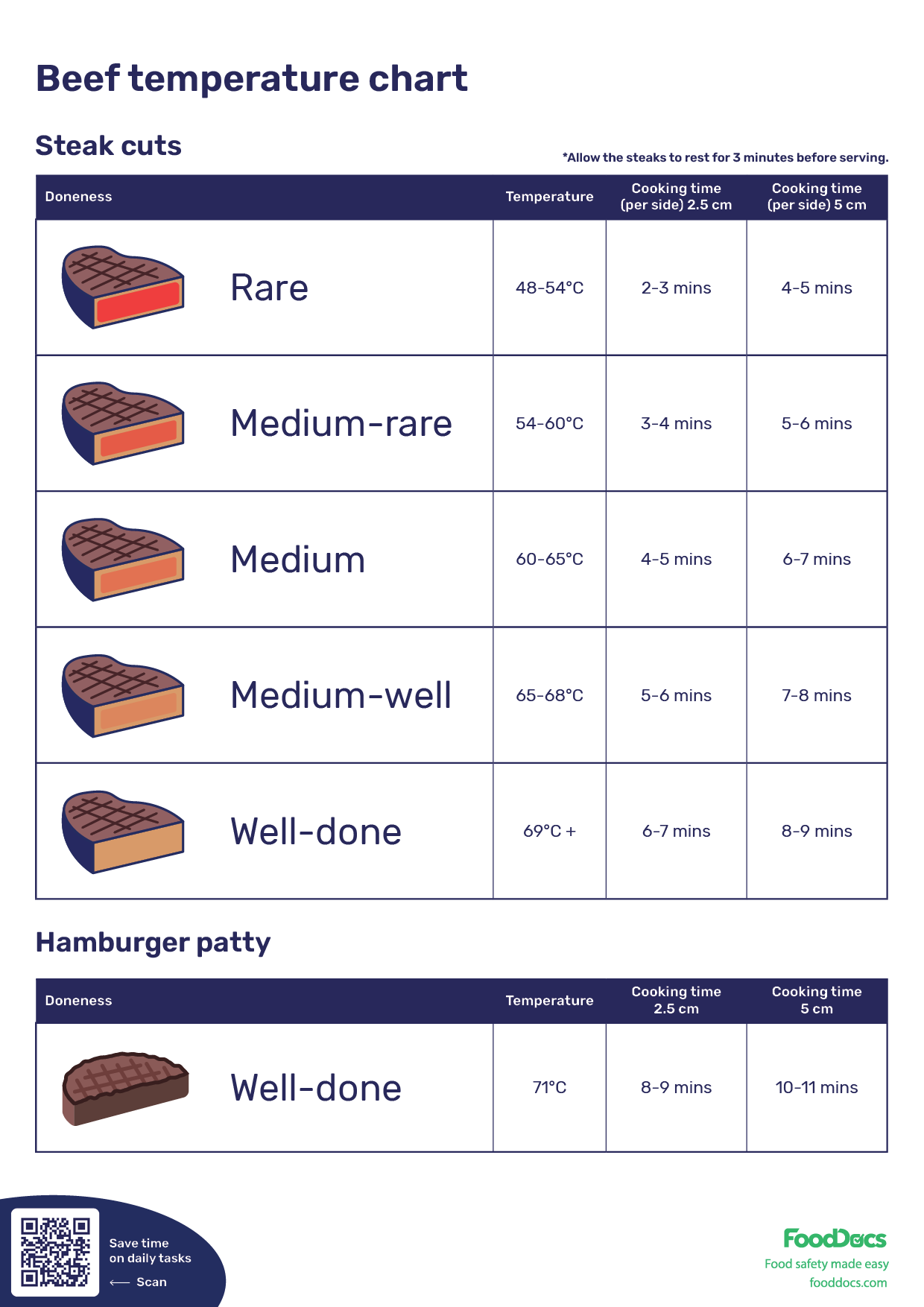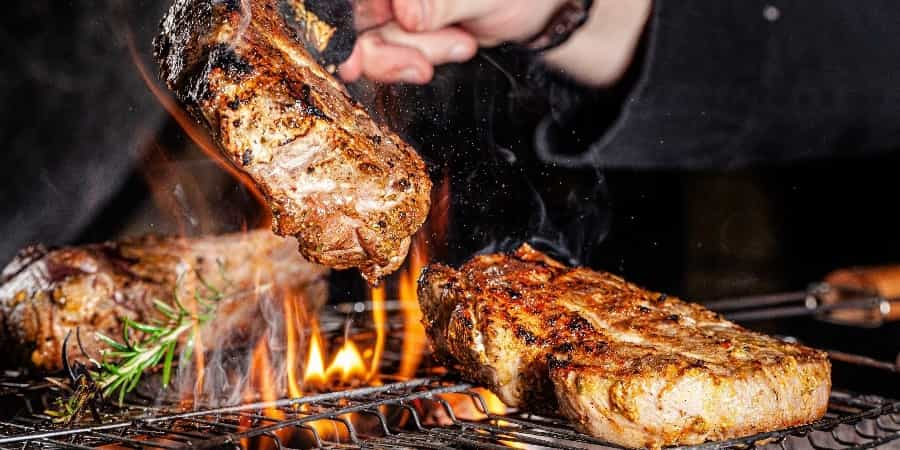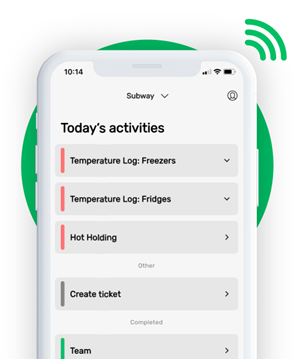BEEF TEMPERATURE CHART


This is how our Digital Food Safety platform saves 20% of your time on daily tasks:
- Get upcoming task notifications
- Add data into the app
- Check the status of tasks in real-time

When food safety was still handled on paper, I typically spent a couple of hours per day getting the papers and going around checking or completing tasks… Now I can sit down and it's just all there in one place. It takes me 5-10 minutes.
Ruth B.
Store Manager
Beef temperature chart
Beef is such a valuable commodity in the food industry. It is used for many different dishes and is often a staple for some. In the US, an average American consumes 55 pounds of beef per year according to a 2018 survey conducted by the USDA. Beef is often served as hamburgers or the all-time-favorite steak. It is the first meat that comes into mind when we talk about steak. With the very versatile selection of cuts such as sirloin, rib eye, porterhouse, filet, and T-bone, consumers have a lot to choose from. Each cut, not to mention the grade, varies in texture which is very hard to ace. Healthy muscle tissue from a premium intact piece of beef can outshine any other meat muscle cuts. For beginners and general use, a beef temperature chart alongside a meat thermometer would help anyone measure the proper temperatures to get the perfect cook on their steak.
Nothing can ruin a steak experience in a restaurant if they get served the wrong cooking doneness. Since steak can be cooked in a wide range of beef doneness, your customers have the liberty to request for their personal preference. Therefore, you have to be always prepared. In doing so, you also have to ensure that the customers are well aware of the risks of eating the undercooked meat. As a food business owner, you have to be sure that your employees know how to cook a steak well-done and use an instant-read thermometer if a customer requests it for health reasons.
Learn how to use a beef temperature chart to ace steak orders every single time for your food business in this article.
What is a beef temperature chart?
A beef temperature chart is a visual guide on how to properly cook beef to the correct internal temperature. Beef, like any other type of meat, must be properly cooked to become safe for consumption. Despite this, beef is a meat that can be enjoyed even when slightly undercooked. The varying levels of doneness that beef can be presented in change the flavors, texture, a bit of juice, and visual presentation of the dish. There are five common levels of doneness each with its internal core temperature description in which beef can be enjoyed, especially as steak:
- Rare - red interior with seared outer portion and slightly cooler center
- Medium-rare - pinkish to red innermost portion and slightly firmer texture
- Medium - pink center with slight red and springy texture
- Medium-well - with a very slightly pink and warm center, with a well-seared exterior portion and a nice crust
- Well done - fully brown center, seared exterior portion, brown crust, and thoroughly firm texture
Each stage of doneness can be achieved through a particular maximum and minimum temperature gradient. Cooking beef thoroughly ensures the rapid destruction of harmful bacteria from the meat. Because beef can be served undercooked, stricter food handling practices and monitoring must be implemented. To ensure that food businesses would only be serving not only flavorful steak but also safe food using beef as the main protein, the US Department of Agriculture (USDA) has released a set of minimum food safety standards that describe the safe temperatures for cooking beef and other cuts of meat. These suggestions include ground chicken or any other ground poultry. The suggested temperature gradient is the final cooked temperature for beef before removing it from the heat source. A few degrees below target temperature can result in a different degree of doneness or can fall to dangerous temps for high-risk groups.
These standards, especially for well-done, were built based on the minimum constant temperature needed to inactivate dangerous bacteria. Consuming undercooked meats, including ground meats, have led to several foodborne illnesses in the part. This is why in combination with offering the possibility to order undercooked beef to your customers, they must also be aware of the risks tied with their choice. Especially customers in the high-risk group can be very vulnerable to food poisoning.
Serving rare to medium-rare steak doneness is more of a quality choice and personal preference rather than a matter of safety. Eating juicy, pink-red meat can be risky for some. These levels of beef doneness offer a softer texture and different eating experience to consumers. In trying to achieve a particular stage of doneness, cooking steaks with accurate readings from a handy digital thermometer and a beef temperature guide can help you do the job accurately. In addition, try to consider the suggested resting time which is three minutes before carving against muscle fibers. Allow the meats to rest in a baking tray lined with paper towels on the surface.
Who needs a beef cooking temperature chart?
A beef cooking temperature chart can be used by any food establishment that serves beef and allows customization of the level of doneness. It can be used by any restaurant, food truck, retailer, or deli store that has a collection of recipe ideas using beef. Food employees can use this beef cooking chart as a guide to properly cook beef. Additionally, home cooks can also use this steak temperature chart for the next time that they need to cook beef at home. Knowing that a cooking thermometer probe must be inserted into the meat midway is not enough to get the perfect doneness. An accurate thermometer must be paired with a cooking temperature chart to ensure proper doneness.

What are the benefits of a beef temperature chart?
More than the quality of beef dishes, a beef temperature chart contains proper cooking temperatures for preparing any beef recipe. Accurately cooking beef dishes as requested by your customers can ensure satisfaction and safety. For customers who are aware of being in a high-risk group such as being pregnant, elderly, or an immunocompromised individual, ordering a well-done beef dish may be the only choice they have.
- Reminder. Offering different levels of doneness for cooking beef can be confusing for some food employees. A beef or steak temperature chart can help ensure that every order of a beef dish will always be properly handled and cooked. Unintentionally serving undercooked beef to a consumer increases the risk of causing any foodborne illness. Cooking beef to a well-done level means reaching a cooked temperature of at least 155°F (69°F). This level of doneness ensures that all potentially harmful bacteria that might be present on beef are removed. With a beef meat temperature chart, employees will have a reference as they gather any accurate temperature reading of the internal cooking temperature using a digital food thermometer. Similarly, the correct cooking temperature for ground beef used for a hamburger patty should be included in a beef temperature chart. Raw hamburger has been infamously linked to one of the largest foodborne illness outbreaks in the food industry because of contaminated meat surface and improper meat temperature cooking. Remind your employees of temperature guidelines using this chart.
- Food safety protection for consumers. Consuming undercooked beef has been linked to several foodborne illnesses. These cases were caused by bacterial growth from pathogens such as E.coli, Staphylococcus aureus, Listeria, Campylobacter, and Clostridium. While the quality of the raw meats plays a huge part in the initial load of these microorganisms, cooking them to a safe temperature ensures that these pathogens are removed. Proper cooking is a part of basic food safety practices that help keep consumers safe from potential hazards. Remember that a few degrees below target temperature can significantly change the outcome of the cooking process. With a beef cooking temperature chart and a cooking thermometer around, you can rest easy that your employees are well guided with the proper way to cook beef.
- Help keep your food business away from complaints and bigger problems. As soon as a food safety complaint gets filed, this means trouble for your food business. Not only is this bad publicity for you, but it can also mean a loss in profit and potential lawsuits from customers. Foodborne illnesses can range from mild stomach cramps to life-threatening situations. One sure way to prevent these unwanted situations from happening is to properly train food employees on how to use a beef temperature chart for accurate application.
- Ensure quality of food items. In addition to focusing on safety, a beef temperature chart can help employees ensure the quality of the food that you will be serving. A beef temperature chart takes note of how a beef dish must be allowed a three-minute rest time before carving for carryover cooking from the residual heat after removing from the heat source. If a customer orders a medium-well cooked beef, that means they are looking for the slightest hint of pink center with a seared cooked color on the outside. The final cooked temperature and constant cooking are keys to achieving this level of cooking.
- Employee training. Surely, a restaurant would not serve only one type of dish. Any food establishment can serve any piece of meat including pork, poultry, venison, and others in addition to beef. These raw meats have their target temperature gradient. For accurate readings, employees must learn how to insert the thermometer midway into the thickest part of the meat at a downward angle. A few degrees below target temperature can significantly increase the risk of foodborne diseases. As such, food employees must be properly oriented on how to safely cook beef and other dishes. A beef temperature chart can be used as an orientation tool for employees.
In addition to cooking beef to the correct internal cooking temperature, customers must also be aware of the risks of ordering and consuming undercooked beef. Pair your beef cooking chart with a consumer advisory that you can display anywhere in your foodservice area for the information of customers.
How to create a beef temperature chart?
Because a beef temperature chart's main objective is to provide employees with a guide for properly cooking beef, that means that the information on the chart must be accurate and factual. Providing an inaccurate and erroneous temperature for beef cooking can significantly cause problems for your food business. In making a beef temperature chart, or any cooking chart for that matter, the following key elements must be applied:
- Fact-checked. Food safety agencies such as the USDA have established safe cooking temperatures for any type of raw meat. These temperatures and cooking time are based on the minimum cooking standards to achieve a safely cooked dish. Use only information that has been reviewed by authorized food safety agencies for the information that you will be putting on your beef temperature chart.
- Accuracy. In addition to food safety concerns, temperature and time combinations for cooking raw beef to rare and medium-rare doneness levels must also be accurate. These levels of doneness are not officially endorsed by food agencies. This is because these doneness levels still contain a very high risk of causing a foodborne illness. Although, parameters to achieve rare and medium-rare doneness are widely available. Make sure that the information you choose has been validated by your source. You can also use your in-house parameters given that you have validated them accordingly.
- Clarity. An important element for a very busy kitchen is that information must be presented. Confusion can arise from using very small fonts or unclear separation of data. Make sure that the information is properly segregated and that it can easily be seen from afar to avoid mistakes.
- Updated. Every now and then, food safety agencies and researchers update time-temperature combinations for cooking different ingredients. These updates usually aim for a more efficient way of cooking. Make sure to consult with your local food safety authorities or check recently published studies on beef cooking temperature.
Making a beef cooking chart can be very easy. You can create one on your own or hire a professional artist to do one for you. What we could say is the best way to get one is to use our free beef cooking chart. All the information in our chart is checked for accuracy and has been presented in a very clear format. This beef cooking chart is just one of our many cooking temperature charts and templates. Visit our HACCP plan template hub for more free checklists, templates, posters, and even a free consumer advisory.
The digital solution for monitoring cooking temperature
Accurately cooking your beef dishes is not only done to satisfy your customer demands but to also protect them from potential food safety problems. This means that consistent cooking temperature monitoring and cooking procedures in addition to other food handling practices must be implemented. Your monitoring system in your food business can help you protect your team from any fraudulent accusations or mere food safety-related problems. Monitoring all of these tasks can be a part of a working and comprehensive food safety management system (FSMS).
The next problem would be how to properly designate the monitoring tasks and to make sure that they will be implemented every day of your food business operations. Luckily, our team at FoodDocs has taken these concerns as inspirations to build a more efficient FSMS for everyone in the food industry. What we offer is a way for your food business to switch to a digital platform and get smart features that will make your food business operations easier in just an average of 15 minutes.
At FoodDocs, one of our main products is a digital Food Safety Management System that is automatically built based on your daily operations. All it takes to get one is for you to answer a few questions about your business and our system does the rest. In an average of 15 minutes and with the help of artificial intelligence, our system can come up with a comprehensive digital FSMS for you.
To help you maintain food safety compliance through a smart monitoring system, our digital FSMS program offers the following features:
- Automatically generated digital monitoring forms based on your daily operations. These forms can be set to be automatically filled based on your previous data entries. This helps save your employee's time and all that is left to do would be to verify the information.
- Never miss a task with our smart notification feature. Using our mobile application, our system will send you timely notifications to alert you of any food safety task to be done in a day. Additionally, this feature can be used to remind your team of any certification or audit schedule near their due.
- Our system also features a real-time food safety dashboard that can help you save at least 20% of your time from micromanaging your operations. This dashboard offers real-time analytics of your operational efficiency and can locate areas that need improvement.
- Get dedicated cloud storage where you can store, organize, and access all digital documents in one place.
Choosing to go digital means a step towards sustainability. You would not need any more extra space to file your daily monitoring documents. This also saves up on the paper that you will be using for all of your paper files. To add, the sweetest thing is that you do not need any highly technical knowledge to operate our digital FSMS. All it would take is just 15 minutes of your time.
Ensure that all of your cooking procedures are accurate and well documented using our digital FSMS. Maintain compliance using a more efficient system to gain more time which you can focus on improving your daily services with FoodDocs. Sign up now and avail of our free, 14-day trial to build and test our digital FSMS.












